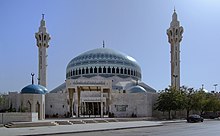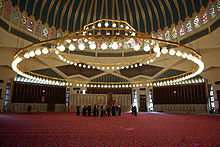King Abdullah Mosque (Amman)
The King Abdullah Mosque ( Arabic مسجد الملك عبد الله الأول, DMG Masǧid al-Malik ʿAbd Allāh al-awwal ) is a major mosque in Amman , Jordan .
The mosque was built between 1982 and 1986 by order of King Hussein I and named after his grandfather Abdallah ibn Husain I , the emir and first king of (Trans) Jordan . The plans go back to the work of the Bohemian-German architect Jan Cejka (* 1933).
The mosque is located on the hill Jebel al-Weibdeh in the western part of the Jordanian capital. Its characteristic blue main dome, decorated with mosaics, has become one of Amman's landmarks. In addition, two smaller domes and two futuristic-looking minarets rise. The dome houses a prayer room (for men) below; it is not supported by columns in the central nave and is reminiscent of the Dome of the Rock in Jerusalem .
A museum of Islamic history and religion is located in the mosque complex. The mosque is the only mosque in Amman that is also open to non-Muslims.
Since April 11, 2006, the King Abdullah Mosque is no longer the Jordanian national mosque. It was replaced by the King Hussein bin Talal Mosque built by King Abdullah II in 2004-2005 in memory of his father Hussein I, currently the largest mosque in Jordan.
Web links
- History of the mosque (accessed March 12, 2010)
Individual evidence
- ^ Dorothy Stannard: Jordan. Apa Guide. Apa Publications, Munich 1995, ISBN 3-8268-1443-6
- ↑ Graphics and painting - Jan Cejka - object and fiction exhibition in the Kulturhof Westerbeck in Westerkappeln from 1. – 31. May 2009
- ↑ http://www.lonelyplanet.com/jordan/amman/sights/religious/king-abdullah-mosque , article on the Lonely Planet website , accessed April 11, 2016
Coordinates: 31 ° 57 ′ 41.7 " N , 35 ° 54 ′ 47.2" E

